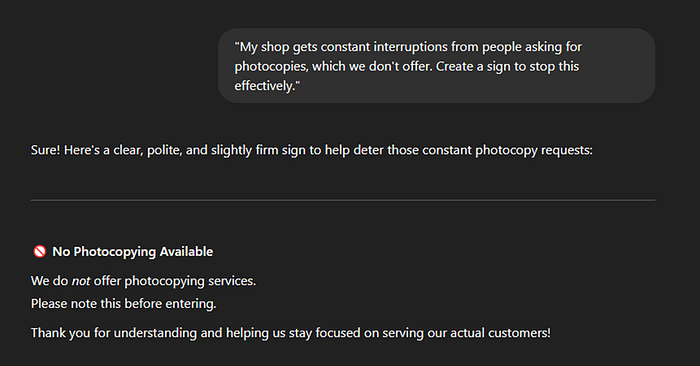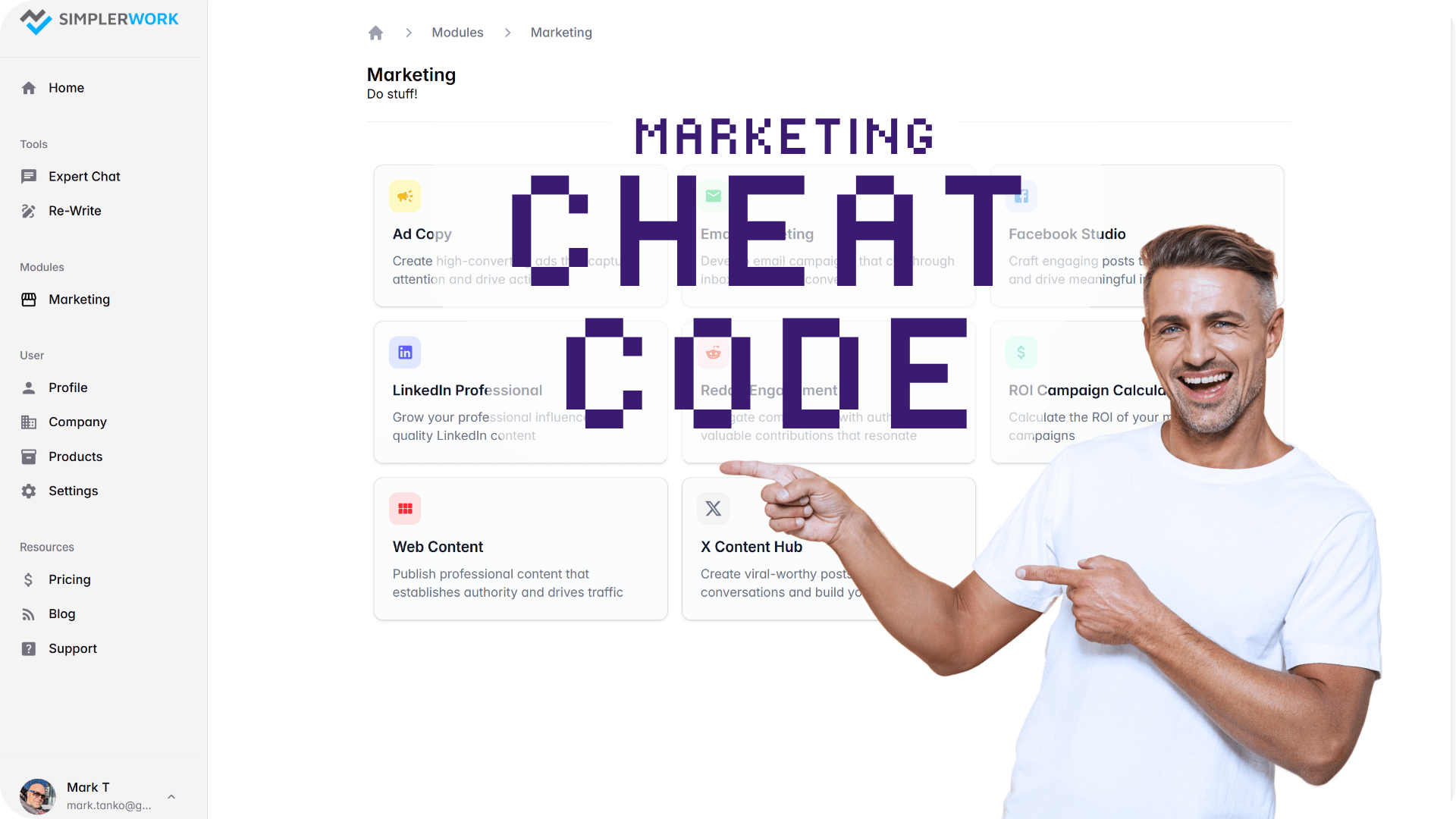- The Tools
The Tools of Your Trade
What is SimplerWork
Find out Find out
all about?
- Pricing
- About
- AI Insights

This sign in a Serbian storefront amuses me for the lovely passive aggressive growl Serbs have honed for generations, but we’ve all seen the same sign a million times in every language.
It reads, “WE DONT DO PHOTOCOPYING.” (Ne radimo fotokopiranje) Below it, an almost exasperated addendum: “And we don’t know who does” (Ne znamo gde ima.)
Ignored by most, amusing to some, and a seizure trigger to a marketer. What leads a business owner to get so bothered by requests for a service they don’t offer that they create a sign explicitly to shut those requests down? Even more, a subtitle that angrily refuses help? It’s more than just passive aggression; it’s a sign of a profound disconnect.
The question hangs in the air: If that many people need copies badly enough to constantly interrupt you, why not offer photocopies? Why deflect the demand instead of capturing it? This simple sign becomes a strong metaphor for how we think, how we miss opportunities, and how human insight often fails.
Lately I find myself increasingly pulled into discussions about AI replacing people, those people, and we’ll address why that’s not a solution below.
Thinking in Layers: Beyond the Immediate Problem
To unpack this, let’s frame it using “Cognitive Layers”:
- Layer 1: The Surface Task. This is the immediate friction — the annoyance of interruptions. The problem definition here is simple: “Stop people from asking.” The sign is the direct Layer 1 solution. . It directly addresses the symptom. Task executed. Problem (as defined) solved.
- Layer 2: The Underlying System & Opportunity. This requires looking deeper. Why are people asking? Consistent requests are raw market data signalling unmet demand. Defined at this layer, the problem becomes: “There’s a clear need here; how can we capitalize on it?” Buying a copier is a Layer 2 action — addressing the root cause by seizing the opportunity.
The sign-maker was firmly planted in Layer 1, optimizing for reduced annoyance rather than increased value.
Why We Often Stick to Layer 1
It’s easy to criticize from afar, but let’s make one thing absolutely clear: staying on Layer 1 isn’t a “dumb” thing to do or a sign of personal inadequacy. There are perfectly human, often systemic, reasons why someone might see the signal but not act on it.
- Focus and Bandwidth: Maybe the shop owner struggles to keep up even with their primary business. Adding a new service, even a simple one, requires time, attention, and process changes they simply can’t afford. Their focus is elsewhere, necessarily narrowed.
- Resource Constraints: Perhaps there’s genuinely no physical space for a copier. Maybe the upfront cost, however small, is prohibitive. Practical limitations are real.
- Cognitive Biases: We’re all susceptible. Status Quo Bias whispers that it’s easier to keep things as they are than to introduce change. Functional Fixedness might prevent seeing their retail space as potentially serving an additional ‘office services’ function.
- “Not My Job Syndrome” (NMJS): This is a big one in any organization, big or small. Even if an employee saw the opportunity, they might have felt it fell outside their defined role or the shop’s core identity. “We sell X, we don’t do copies.” It’s the business equivalent of seeing a glaring typo on a massive company billboard — countless people in marketing, design, printing, and installation might spot it, but if fixing it isn’t explicitly their job, it often goes uncorrected. It’s a failure of process, culture, and empowerment, not necessarily individual competence.
Moving from Layer 1 to Layer 2 isn’t always a simple cognitive leap; it’s often entangled with practical realities and operational habits, or even the F word (feelings).
Enter AI: The Master Executor, Confined by the Mandate
Now, let’s bring AI into the picture. Imagine feeding the Layer 1 problem to a typical AI tool.

AI generated a fascinating Layer 1 solution. It added an icon, we all love clear icons telling us “NO”. It said what the business refuses to do, it also added a little “don’t you dare even step inside” note. Not sure if it figured out it was being a bit rude, but it capped off with an explanation about the business logic that made us tell you to go away. We’re nice to our actual customers!
It executed the mandate — make a better sign — with superb efficiency. When asked to create a printable visual sign, it really delivered:

A framed message, printer image crossed out, the correct balance of font size and weight to efficiently tell you that you’re not welcome.
The important thing is what it didn’t do. Unprompted, it didn’t challenge the premise of the task. At no point did it ask about why, find “constant interruptions”, link to “unmet demand” and suggest a Layer 2 solution.
“Hold on,” you’d hope it might say, “The data ‘constant interruptions’ suggests significant local demand. The follow-up suggests that there’s little to no convenient competition, offering lots of pricing headroom. Before optimizing a sign to deflect customers, have you analyzed the potential ROI of offering this service?”
This kind of spontaneous, strategic leap is outside the scope of AI models. While they are rapidly evolving, the core strength of AI lies in executing tasks within the parameters it’s given. It doesn’t inherently possess the contextual business acumen or the drive to question the ‘why’ behind the ‘what’ without specific strategic prompting.
Where it did stray from the limits of the mandate in the early days, we called it “hallucinations” and we developed strict guardrails to prevent hallucinations from happening.
Hoping AI will fix process problems rooted in human systems is probably a lost cause. It might just execute the flawed process faster.
The Real Creative Leap: Connecting the Dots
This highlights what true creativity and strategic thinking often entail. It’s not merely about generation; it’s about perception and connection.
- It’s reading the signal within the noise — interpreting copy requests as market feedback, not just annoyances.
- It’s applying contextual understanding — knowing the local environment and needs.
- It’s the discipline to “Stop and Ask Why” — Why here? Why this need? What does it reveal? This questioning is what bridges the layers.
- It’s making the strategic leap — connecting data, context, and insight to formulate a new course of action (like offering a new service).
This is the vital difference between optimizing the current state (a better sign) and transforming it (a new service).
Human Value in the Age of AI: Be the Layer-Bridger
AI improves its handling of complex Layer 1 tasks daily. Let’s be honest here, my 5-second example sign is already far better than the sign in the photo. Your unique contribution lies less in doing the task AI can handle, and more in directing it to what really matters.
Your personal value proposition involves:
- Identifying the right problems: Are we optimizing the sign, or questioning if we need it?
- Seeing the underlying systems: Recognizing patterns and connections AI might miss without guidance.
- Asking the crucial “Why?” and “What If?” questions: These are the prompts that unlock AI’s true potential.
- Navigating the messy human context: Understanding the biases, culture (NMJS!), and constraints AI doesn’t grasp.
- Acting as the Layer-Bridger: Making the connections, forming hypotheses, and guiding AI to analyze and execute across layers.
The (business) future belongs to those who master this human-AI symbiosis: leveraging AI’s power while providing the critical, contextual, and strategic insight that gives it direction and purpose.
Conclusion: Look Beyond the Sign, See the Signal
That simple sign is a small monument to a missed opportunity, an ignored insight, a failure — perhaps systemic, perhaps pragmatic — to bridge the gap from surface frustration to an underlying opportunity. It’s a symbol of the powerful inertia of Layer 1 thinking.
In a world increasingly filled with tools that can optimize, automate, and generate on command, our most vital work becomes clearer: Cultivate the curiosity to look deeper. Find the courage to question the immediate task. Develop the insight to connect the dots others miss.
So, how can you apply this layered thinking?
- If you sometimes feel like the “sign-maker” (figuratively): Maybe you’re overwhelmed by recurring issues or “annoyances.” Take a step back. Treat that constant friction as a sign of a trend, as data. Ask yourself: “What unmet need might this frustration actually be pointing to?” You don’t need to overhaul everything tomorrow, but consciously shifting your perspective from reacting to interpreting is the first step toward training yourself to see opportunities.
- If you’re a manager: Is your team hanging Go Away signs or looking for copier opportunities? Shape the environment. Actively fight “Not My Job Syndrome” by rewarding cross-functional insights. Be aware that this type of thinking demands time and space for reflection. Explicitly create that space and give permission for Layer 2 questioning — make it part of the job description to look beyond the immediate task.
* Some companies call this side project time, but it can be far simpler than that. One company I worked for years ago tried to ban smoke breaks until the whole team explained to the CEO those 10-minute chats were where we worked out all the “photocopier” moves that grew the business. - If you’re a marketer trying to understand AI: This framework is crucial. Let AI draft copy, analyze sentiment data, optimize campaigns — excel at Layer 1 execution. Focus your unique human value on the ideas. Deeply understanding the why behind customer behavior, spotting the unmet needs often hidden in qualitative feedback (even the “annoying” kind!), and defining the overarching strategy. Your core job isn’t just writing the sign better; it’s understanding why people are showing up in the first place and deciding if you should be selling copies.
Ultimately, don’t just focus on what’s in front of your nose. Train yourself, build your teams, and orient your strategies to see the signals that tell you it might be time to buy the copier.





